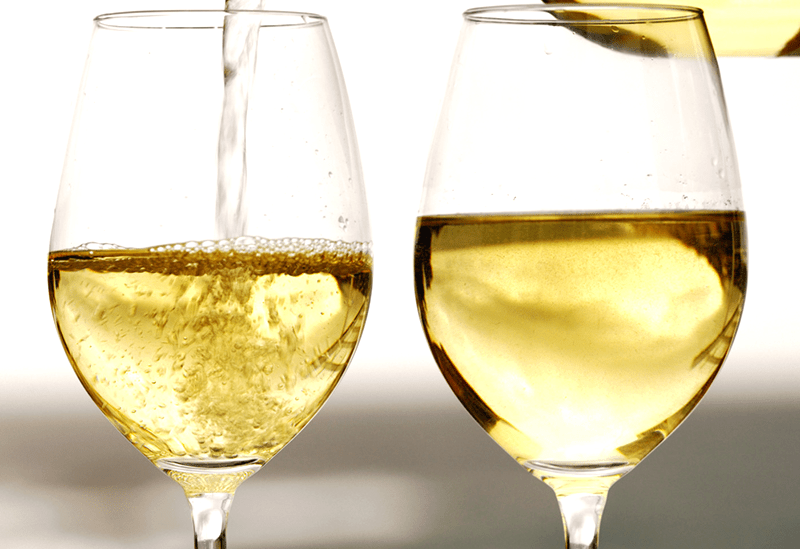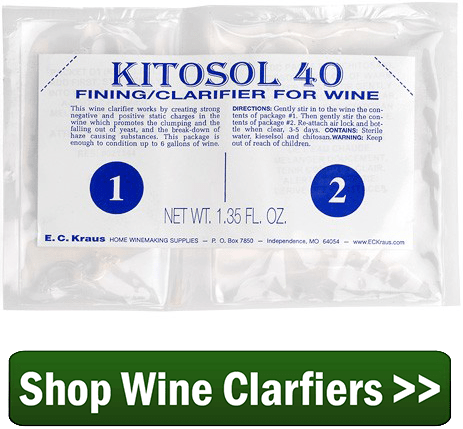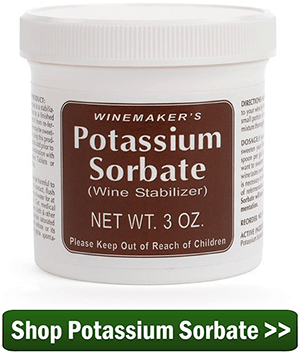 I am new to making white wine (past 3 seasons). I have made red for about 10 years. I use fresh California grape wine juices in Sept. I have not figured out how to keep my whites from clouding after bottling. I rack several times then cold stabilize and rack several more times and the wine is clear. Any suggestions on where I might be going wrong.
I am new to making white wine (past 3 seasons). I have made red for about 10 years. I use fresh California grape wine juices in Sept. I have not figured out how to keep my whites from clouding after bottling. I rack several times then cold stabilize and rack several more times and the wine is clear. Any suggestions on where I might be going wrong.
Name: Jerry
State: NY
—–
Hello Jerry,
There are only three ways that a white wine can turn cloudy once it has already been clear. I will go over them in some detail, but it will be up to you to determine which one or which ones are responsible.
- Sediment From The Original Fermentation:
You mentioned that you have racked the wine several times, and that the wine was clear at bottling time. This is all well and good, but it is important to understand that a wine can look perfectly clear and still have a lot of wine yeast cells still floating around in it. This is why that once you rack a wine off its sediment you may want to give it some additional time, like a day or two, to make sure that sediment is still not occurring before actually bottling the wine. This same hold’s true for red wines.
Using a fining agent can help with dropping out stubborn sediment. A good one for white wines is Isinglass. And lastly, never bottle your wine directly off the sediment. Always bottle your wine from a sediment-free fermenter. That means racking the wine off the sediment before starting the bottling process.
- A Re-Fermentation In The Wine Bottle:
If the wine decides to ferment again while in the bottle, it is going to turn cloudy from the new yeast that is created. A re-fermentation can occur if the original fermentation did not complete. It can also occur if you added sugar at bottling time without adding potassium sorbate to stabilize the wine.
A quick check with a wine hydrometer to confirm that the fermentation has completed before bottling should always be done. Doing so will eliminate this type of issue, and always use potassium sorbate when sweetening a wine before bottling. Fortunately, it is easy to determine if this is the reason your wine turned cloudy. You will also notice pressure building up in the wine bottle. This is the CO2 gas from the re-fermentation.
quick check with a wine hydrometer to confirm that the fermentation has completed before bottling should always be done. Doing so will eliminate this type of issue, and always use potassium sorbate when sweetening a wine before bottling. Fortunately, it is easy to determine if this is the reason your wine turned cloudy. You will also notice pressure building up in the wine bottle. This is the CO2 gas from the re-fermentation.
- Precipitation From The Wine:
Precipitation occurs when particles are created within the wine itself — out of thin air, so to speak. There are two major kinds of precipitants that can be created by a wine. The first is acid, primarily tartaric acid. The second is protein, primarily tannin. Tartaric precipitation is normally associated with white wines. Protein precipitation is normally associated with reds.
Precipitation happens because more of the substance is in the wine than the wine can hold in a saturated form. Given time, either of these substances can form sediment in the bottle and cause your wine to turn cloudy. Acid precipitation will look like tiny crystals, similar to a fine salt. Protein precipitation will look like a fine dust or flour. In the case of your white wine, the color would be beige to brown. In a red wine it would be dark red to black.
Precipitation is even more likely to occur if the wine is being stored too cold or too hot. Chilling the wine may induce the creation of acid crystals; heating the wine may induce the creation of tannin particulates.You mentioned that you cold stabilized the wine, but if you see crystals forming in the bottom of the wine bottle, it is very likely that you need to chill the longer.
Jerry, there are really no other reasons why a bottle of grape wine would turn cloudy. If you where adding water to the wine must then you would want to consider too much iron in the water as the problem. This could form a condition called ferric casse. But since you are making wine from wine grapes, I am assuming that you are not adding water.
I would suggest reviewing your steps and see if any of the above 3 could possibly apply to your situation. Another blog post that you may want to read that answers your question in a different way is, Sediment In My Wine Bottles. This may be something that you may want to take a look at as well.
Happy Winemaking!

Very interesting article about clouding and crystalizing/and tartaric acid and tannin protien. Any tips on how you chill or heat 6 gal carboys once they are racked 4 times, fined, and stabelized before bottleing? Also how cold or hot should the wine be to eliminate bottle sediment?
Greg, when it comes to cooling down, the cooler the better. Or, the cooler the wine is, the faster any crystals will form that are to form. But in theory, as long as the wine is brought down to a temperature that is cooler than the temperature that it will be stored at in the bottle, this will be sufficient if done so long enough. When warming the wine you must be much more gentle, so much so that I am hesitant to even recommend it to you. Oxidation of the wine is the biggest concern here. When you warm a wine it increases the rate of oxidation dramatically, cause the wine to go amber or orange. I would recommend treating the wine with bentonite instead to drop out the excessive tannins.
having racked my wine several times over 6 months filtered it before bottling looks perfectly clear, let in the bottle a few months and find a line of sediment in the bottle this is laying horizontal in 55 degree cabinet what caused the sediment to form ?
Ed, if the fermentation completed and the wine was filtered, it sounds like you might be experiencing acid precipitation. I would take a look at the article posted below for more information and how to treat the wine.
Acid Precipitation
http://eckraus.com/wine-making-stabilization/
I bottled my wine clear, then 3 months later there is a very fine cloudy haze. I am not new to winemaking, and have many great vintages- but this is a first. What gives?
The article you posted this comment on is the article I would have sent you to. It has got to be one of these 3 things.
Can you get sick from CLOUDY HOMEMADE VIN BON WHITE WINE?
Brie, It is almost always safe to drink a cloudy wine, unless the sediment is the result of a bacterial infection, in which case your wine will smell bad enough that you don’t want to drink it anyway. Sediment in wine is not hazardous and does not usually affect the flavor.
Thank you for this highly informative article. I am Ayurvedic physician from India. Ayurveda is the traditional Indian system of medicine. In ayurveda, we make different types of medicinal wines. It is quite interesting to get the modern inputs regarding wine making. Thank you